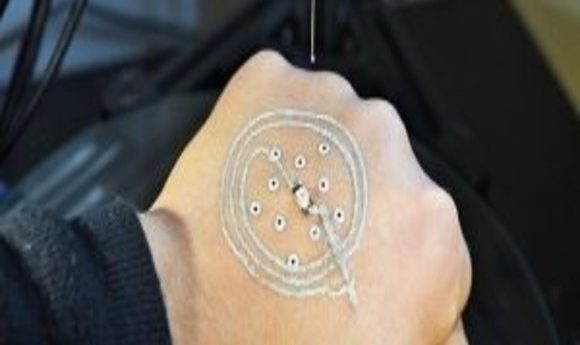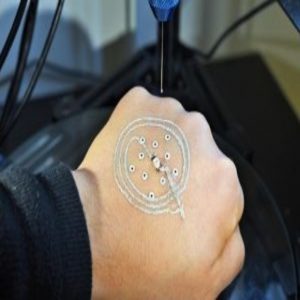3D printing on skin

A low-cost 3D printer has been developed to print electronics and cells directly onto the skin.

One of the key innovations of the new 3-D-printing technique on skin is that the printer uses computer vision to track and adjust to movements in real-time.
Credit: McAlpine group, University of Minnesota
In a study published in Advanced Materials, scientists at the University of Minnesota (MN, USA) report that they have successfully printed working electronics on the human skin. They also report printing biological cells onto the skin wounds of a mouse. All this was achieved using an inexpensive, portable 3D printer.
3D printing has become a major tool in scientific and technological development. Declining costs and increasing development of user-friendly devices indicate that this modern technology can only continue to grow and grow. Printing directly onto the skin has many possibilities that author Michael McAlpine is enthused about.
“We are excited about the potential of this new 3D-printing technology using a portable, lightweight printer costing less than $400. We imagine that a soldier could pull this printer out of a backpack and print a chemical sensor or other electronics they need, directly on the skin. It would be like a ‘Swiss Army knife’ of the future with everything they need all in one portable 3D printing tool.”
The researchers in this study wanted to develop a cost-effective printer that could print directly on to human skin. However, in order to do this, the printer needed to be customised to make it safe and functional.
To allow the printer to adjust to the movements of the body during printing, the team added a device that scanned pre-placed markers and adjusted the printer to compensate for deviations from these markers — as McAlpine explains,
“No matter how hard anyone would try to stay still when using the printer on the skin, a person moves slightly and every hand is different. This printer can track the hand using the markers and adjust in real-time to the movements and contours of the hand, so printing of the electronics keeps its circuit shape.”
To make the printer safe to use on human skin the team used a special ink made from silver flakes. Unlike conventional 3D-printing inks, this ink cures and conducts at room temperature, preventing burns.
However, this wasn’t the only special ink the team used. Remarkably, they successfully used a special bioink to 3D print cells onto wounded mouse skin to repair it. In the future, printing techniques like these could be used to treat skin diseases and burns in place of grafts. McAlpine is hopeful the field will continue to develop.
“I’m fascinated by the idea of printing electronics or cells directly on the skin. It is such a simple idea and has unlimited potential for important applications in the future.”